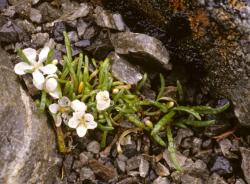- Taxon
- Gallery
- ≡ Claytonia calycina Colenso, Trans. & Proc. New Zealand Inst. 28: 592 (1896)
- ≡ Neopaxia calycina (Colenso) Heenan, New Zealand J. Bot. 37: 220-222 (1999)
- = Claytonia australasica var. biflora Buchanan, Trans. & Proc. Roy. Soc. New Zealand 3: 210 (1871)
Herb, up to 50 cm diam., forming loose or compact mats. Leaves up to 50 × 2 mm, narrowly lanceolate to ± linear; lamina narrowly elliptic to narrowly lanceolate; adaxial and abaxial surfaces green, green-brown, to brown, usually glossy; adaxial surface convex; abaxial surface ± flat; apex obtuse; base attenuate; petiole indistinct and grading into lamina; old leaves yellow to orangeyellow. Involucral leaves 1.2–2.2 × 2.6–3.0 mm, redbrown, red-green, to brown-green; lateral fold present; apex subacute. Flowers 8.0–11.0 mm diam. Tepals 4.5–5.5 × 2.5–2.7 mm, broadly elliptic to obovate, white at maturity—in bud sometimes flushed pink, not overlapping; apex obtuse, not notched; claw weakly differentiated. Nectary orange-brown. Filaments 3.2–3.6 mm long, >½ tepal length, white but rarely flushed pink. Anthers 0.7- 0.8 × 0.3-0.4 mm, pink to pink-red. Ovary 0.8-2.1 × 0.8-1.7 mm, obovoid, green-brown to olive-green; sutures not prominent. Style 2.0-2.3 mm long; slightly spreading at base, white with base flushed green. Stigmatic branches 0.9-1.5 mm long, white, straight prior to spreading. Capsule 1.8-2.1 × 1.7- 2.0 mm. Seeds 1.2-1.8 × 1.1-1.6 mm, slightly to moderately rugose, dark brown to black-brown. FL Dec-Feb; FT Jan-Mar .
[Reproduced from Heenan (1999, New Zealand J. Bot. 37: 213-234, as Neopaxia calycina (Colenso) Heenan) with permission from The Royal Society of New Zealand.]




